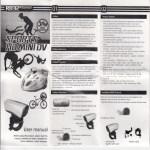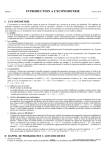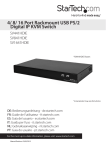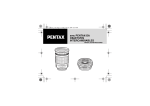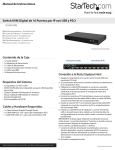Download Vivitar Automatic Fixed Mount Lens 55mm f2.8 Macro Instruction manual
Transcript
To an OM-10 Owner We appreciate very much that you have acquired an OM-10, a camera designed to allow you to take good pictures automatically and with the greatest ease. The Olympus OM-10 is a single lens reflex camera of the finest quality in which the automation of photographic functions has been made possible by employing the most advanced electronics. To its acceptability of Olympus interchangeable lenses, a special film winder, a flash, and a host of other accessories are added to make it a complete system of photography. With the OM-10 you can gradually widen your enjoyment of the photographic art. We sincerely wish that it will become for you a source of unending satisfaction. To this effect, please read this instruction manual carefully before using the camera, so that you may be sure of taking correct, beautiful pictures every time you use your OM-10. 1 TABLE OF CONTENTS Description of Controls . . . 3 Preparations before Taking Pictures . . . . 6 to 15 Mounting and Detaching the Lens . . . . . . . . . . 7 Inserting the Batteries . . . 9 matically . . . . . . . . . 19 The OM-10: Designed to Save Battery Consumption . . . 22 Switching the Camera Off . 23 Rewinding the Film . . . . 23 Unloading the Film . . . . 24 Checking the Batteries . . . 10 Loading the Film . . . . . . 11 Setting the ASA Film Speed . 15 The Way to Automatic Photography . . . . 16 to 25 The Use of the Self-Timer . 25 Photographic Techniques . . . . . . . . . . . . . 26 to 42 Controlling the-Exposure .27 Photography with ShutterSpeed Priority . . . . . . 28 Setting the Aperture . . . . 17 Taking Picture Auto- Exposure Compensation . . 29 2 Long Exposures . . . . . . 30 Flash Photography . . . . . 31 Using the Winder 2 . . . . . 33 From General Photography to the Use of Interchangeable Lenses . . . . . . . . 35 Making Use of the Depth of Field . . . . . . . . . . . . 37 Manual Exposure Control . 39 Care and Storage of the Camera . . . . . . . . . . . 43 Questions and Answers . . . 45 Main Specifications . . . . . 47 DESCRIPTION OF CONTROLS Rewind Release Lever (P. 39) (P. 23) Manual Adapter Socket Shoulder Strap Eyelet (P. 39) Manual Adapte Guide Knob (P. 10, P.25) Self-Timer/ Battery Check Light Self-Timer/ Battery Check Beeper Preview Button Standard Lens 3 The photo indicates OM-10 camera body with the 50mm F1.8 standard lens. (P. 37) (P. 17, P. 27) (P. 8) Lens Release Button (P. 19) Depth of Field Scale Aperture Ring Focusing Ring Lens Mount Ring (P. 29) (P. 15) Rewind Knob/ (P. 11, P.24) Camera Back Release (P. 30) Exposure Compensation Dial Mode/ASA Film Speed Dial Mode Index (P. 22) Rewind Crank (P. 22) (P. 24) Shutter Release Button Activator Switch Exposure Counter (P. 14) Selector Dial (P.30, P.39, P.49) (P. 17, P.23, P.25) Mode Selector Lever (P31) Accessory Shoe X Contact 4 Film Advance Lever Flash Charge/Auto Check Contact (P. 18) Shutter Curtain Film Rewind (P. 13) Shaft (P. 12, P. 13) (P.11) Viewfinder Eyepiece Frame Sprocket Film Take-up Spool Camera Back Film Pressure Plate Film Cartridge Pressure Spring (P.11) Film Chamber Film Guide Pins Body Mount Ring (P. 33) Tripod Socket (P. 33) (P. 33) (P. 33) (P.9) 5 Winder Coupling Terminal Winder Coupling Socket Guide Pin Hole Battery Chamber PREPARATIONS BEFORE TAKING PICTURES The OM-10's circuits are powered by two 1.5V alkaline-manganese or silver oxide batteries. Without them, the shutter of this electronic single lens reflex camera will not function. This section is devoted to explaining the preparations which you must go through before proceeding to take pictures. Please keep in mind that they are indispensable for obtaining good results. 6 MOUNTING AND DETACHING THE LENS Remove the front lens cap. Remove the body cap and the rear lens cap.* * If you have purchased an OM-10 in conjunction with a lens, the body cap and rear lens cap are not provided. 7 Mount the lens. Detach the lens. 8 INSERTING THE BATTERIES Insert two 1.5V alkaline-manganese batteries Remove the cover of the battery chamber. LR44 (A76). Replace the cover. (NOTE) Two 1.5V silver oxide batteries SR44 (Eveready EPX-76) or equivalents can be also used. 9 CHECKING THE BATTERIES Move the selector dial to "CHECK". A beeping sound is heard and the battery check light turns on. After the check set back the dial. (Attention) If no sound is heard and the light does not turn on, the batteries have not been correctly inserted, or their charge is exhausted. In this case they must be replaced. 10 LOADING THE FILM Load the film. Open the camera back. (Never load or unload the camera in direct sunlight.) 11 Insert the film leader in one of the slots of the take-up spool. The film leader must not be excessively drawn out. (The film leader is twisted.) (The film leader does not enter completely.) 12 (The film leader is excessively drawn out.) Wind the film once. The perforations of the film must engage with the sprocket teeth. Make sure it is well tense, and close the back 13 Take blank shots until the exposure counter shows "1". (Ways of taking blank shots) This instance is not suitable for taking blank shots since the automatic ex- posure control built in the OM-10 prolongs the ex- posure time. 14 SETTING THE ASA FILM SPEED Set the ASA film speed. (The ASA film speed dial is set at ASA 100.) 15 THE WAY TO AUTOMATIC PHOTOGRAPHY All the problems of exposure are electronically taken care by the OM-10. It is a single lens reflex camera which can be set for automatic control of exposure, and when set so taking correctly exposed, beautiful pictures could not be simpler. 16 SETTING THE APERTURE Confirm that the camera is set at the "AUTO" position. Set the desired aperture. (Aperture guideline) NOTE: To make full use of the aperture ring, read Set the selector dial at the "ON" position. page 27. 17 The proper shutter speed lights up in the viewfinder. 18 TAKING PICTURES AUTOMATICALLY Focus. 19 Out of focus. Correct focus. 20 When holding the camera horizontally, make sure to press your elbows against your body. Have your elbow pressed against your body when holding the camera vertically, too. THE OM-10: DESIGNED TO SAVE BATTERY CONSUMPTION this light will go off automatically after 90 seconds, to prevent unnecessary battery consumption. < When the activator switch is touched ... > With a light touch on the activator switch, energy will begin flowing again, and the light which had gone out after 90 seconds will turn on again. Gently press the shutter release button. < When the selector dial is turned to the "ON" position... > Energy flows from the alkaline-manganese or silver oxide batteries and a light appears by the shutter speed scale in the viewfinder. However, < When the selector dial is set at the "OFF" position... > No energy will be supplied to the camera's circuits and the light will not turn on. However, if you forget to turn the selector dial to the "ON" position and suddenly you press the shutter release button, energy will flow only during the time the shutter is open, and properly exposed photographs can be taken. Once the picture is taken, all circuits are disconnected as a safety measure to prevent unnecessary battery consumption. 22 SWITCHING THE CAMERA OFF REWINDING THE FILM Turn the rewind release lever when the film ends. Move the selector dial to the "OFF" position when you are not going to take any more pictures. 23 UNLOADING THE FILM Keep rewinding the film until you feel no more resistance. Open the back and unload the film. 24 THE USE OF THE SELF-TIMER Click the selector dial to the position "SELF TIMER". Press the shutter release button. A beeping sound is heard and the self-timer light blinks. The shutter will be released after about 12 seconds. Return the selector dial to its original position. 25 PHOTOGRAPHIC TECHNIQUES The various functions of the OM-10 and the wide variety of lenses, flash, winder, and system accessories which can be used with it allow you to fully master all the techniques which automatic photography can make possible. We shall devote the following section to some of these photographic techniques. 26 CONTROLLING THE EXPOSURE posure), or even blurred images. In these circumstances, make full use of the aperture ring in order to control exposure so as to obtain properly exposed photographs. When taking pictures in a place which is either too dark or too bright, even if you follow the aperture guidelines given on page 17, there will be a tendency to result in whitish photographs (overexposure), or darkened ones (underexWhen a red light turns on in the red zone at the top of the shutter speed scale in the viewfinder it indicates overexposure. In such a case, turn the aperture ring to the higher f-numbers (toward F16) until the light appears within the proper exposure range, and then proceed to take the picture. When the light appears below "30" (1/30 of a second), blur may easily occur. In this case, use a tripod or turn the aperture ring to the lower f-numbers (toward F1.8) until the light goes higher within a range in 27 PHOTOGRAPHY WITH SHUTTER-SPEED PRIORITY When photograhing fast moving subjects, there is a marked tendency to obtain a blurred image of the subject. This can be made use of as a technique to give the impression of movement, by intentionally allowing the image to be blurred, while making use of the shutter speed priority function. Pictures taken with this technique offer an interesting challenge. Turn the aperture ring until the light in the viewfinder appears by the shutter speed value suitable for the photographic situation, and then press the shutter release button. which blur is not likely to occur. When the light appears at "1" (1 sec.), the shutter speed is 1 sec. or longer. In such a case it is recommended to turn the aperture ring to the lower f-numbers within the proper exposure range. 28 EXPOSURE COMPENSATION Before compensation When shooting against the light, or if the subject is standing before a window, the face tends to appear dark on the image. In this case, use the exposure compensation dial to obtain a correctly exposed photograph. Lift the compensation dial and change the film speed set on the dial (within ±2). By this means, it is possible to obtain high or Compensated +2 full stops. low key effects. (+) is for high key (overexposure) and (—) is for low key (underexposure). However it is not possible to obtain (For example, ASA 100 compensated +2 full stops.) compensation for ASA 25. When you finish taking the picture, return the compensation dial to its original position. (-) compensation for ASA 1600 or the (+) 29 LONG EXPOSURES Indoors when it is dark, or when photographing at night, use the "BULB" setting and take the pictures by resorting to long exposures. Of course, blur can easily occur in long exposures so it is recommended to use a tripod and a cable release. Set the mode selector lever to B, and press the shutter release button. The shutter will remain open as long as the shutter button is being pressed. Do not forget to reset at the "AUTO" position after you finish taking pictures. (Continued on page 49) 30 FLASH PHOTOGRAPHY indoors. < Characteristics of flash photography using the T32•T20 > Electronic Flash T32 Mount the Electronic Flash T32 (or T20) on the accessory shoe of the camera. When the ON-OFF switch of the T32 (or T20) is turned on, the normal auto flash control begins working. When turned off, it reverts to the camera's AE photography. It takes but a flick of a finger to change it from one to the other. When the ON-OFF switch of the T32 (or T20) is turned on, the flash will be automatically synchronized at the shutter speed of the Electronic Flash T20 camera. It is possible to verify when the flash is ready because a full charge signal lights in the viewfinder. In addition to the charge signal automatically lighting at you can refer to the shutter speed indicated by another red light in the viewfinder as required by the available light. It is possible to check a correct flash exposure in the viewfinder if the signal light blinks. (Continued on page 49) The T32 and T20 electronic flash units specifically designed for OM cameras provide artificial illumination when you take pictures at night or 31 • • 32 USING THE WINDER 2 Fast moving subjects, such as in sports, car racing, and the like, make you wish to take pictures at a faster pace. The time spent winding the film may mean that a great chance is lost. In these cases, an accurate, reliable power winder for automatic film winding can well be the perfect answer, such as the Olympus Winder 2 which can be attached on the OM-10 very simply, and switched to the single or sequence mode photography. On single mode, it can wind film immediately after exposure, ready for next chance to release the shutter at any moment, and on sequence mode, it can make sequential filming as fast as 2.5 frames per second. (Continued on page 49) 33 34 FROM GENERAL PHOTOGRAPHY TO THE USE OF INTERCHANGEABLE LENSES The main characteristic of the single lens reflex camera is the possibility of using a plurality of different lenses on the same body. From photography with a standard lens to the feeling obtained with a telephoto lens by blurring the background or, on the other hand, by stressing the perspective, giving a special effect to the background by means of a wide angle lens, the world of images which unfolds before you with the OM-10 becomes richer and wider. Olympus Zuiko interchangeable lenses included in the OM System are highly reputed for their sharpness and Wide angle 28mm resolving power. 35 Telephoto 200mm 36 MAKING USE OF THE DEPTH OF FIELD When you have a subject in focus, there is a range in the fore and the background which is clearly defined in the picture. This range is called depth of field. The larger the F number becomes, the wider this clearly defined range becomes, and the background becomes sharper. On the contrary, the smaller the F number becomes, this range becomes less wide, while the background loses contrast and out of focus. By using these properties of the depth of field with creativity and imagination, you will be able to take pictures which will have your own personal imprint. 37 < How to check the depth of field > The photograph is focused at a distance of about 4m (13 ft). In this case, if the aperture is set at F 4, the range which appears clearly defined will be approximately from 3m (10 ft) to about 4.5m (15ft). If an F16 is used, the range will be approximately between about 2m (6.6 ft) and 10m (33 ft). 38 When you want to check inside the viewfinder the correct focusing range, it simply requires pressing this preview button. MANUAL EXPOSURE CONTROL When the optional Manual Adapter is attached to the OM-10, it is possible to revert to manual exposure control. When photographing fast moving subjects, when there is a possibility of camera shake, or when you want to capture the subject in its natural tones no matter what the illumination behind may be, this accessory proves to be very useful. In order to control exposure in such a way as to obtain special effects to match the photographic situation or your own intentions, you must rely on your own expertise and practice. In photography with manual control of exposure, the mode selector lever must be set at the "MANUAL ADAPTER" position. To use the electronic flash T32 or T20 with the Manual Adapter attached on, you must set the mode selector lever to AUTO and the flash unit automatically synchronizes at the shutter speed of the camera. (CAUTION) If an electronic flash other than the T32 or T20 is used with the Manual Adapter, sometimes the shutter is not released at the speed you set on the Adapter due to the noise of the flash. 39 Shutter-speed priority at 1/1000 sec. Aperture priority, high keyed < When shutter-speed priority is advisable > < How to apply aperture priority to your photographic needs > Set the aperture as preferred. Set the necessary shutter speed in the Manual Adapter. Turn the aperture ring while looking through the viewfinder until the light on the shutter speed scale turns on at the shutter speed which Look through the viewfinder to see the shut- ter speed which the light indicates, and set that speed in the Manual Adapter. Then, press the shutter release button. * By intentionally ignoring the indicated shut- was set in the Manual Adapter. Then, press the shutter release button. ter speed, and setting a different one in the Manual Adapter it is possible to obtain high key or low key results as desired. 40 TABLE OF INTERCHANGEABLE LENSES TYPE FISHEYE SUPER WIDE ANGLE ANGLE STANDARD ZOOM TELEPHOTO INTERCHANGEABLE LENSES ZUIKO FISHEYE ZUIKO ZUIKO ZUIKO ZUIKO ZUIKO ZUIKO MC FISHEYE MC MC MC MC MC 8mm F 2.8 16mm F3.5 18mm F3.5 21mm F2 21mm F3.5 24mm F2 24mm F2.8 ZUIKO MC ZUIKO MC ZUIKO MC ZUIKO MC ZUIKO SHIFT 28mm F2 28mm F2.8 35mm F2 ZUIKO ZUIKO MC 55mm 50mm 50mm 50mm ZUIKO MC ZUIKO MC MACRO 35mm F2.8 35mm F2.8 F1.2 F1.4 F1.8 F3.5 S ZUIKO ZOOM 28-48mm F4 ZUIKO MC ZOOM 35-70mm F3.6 S ZUIKO MC ZOOM 35-70 mm F4 75-150 mm F4 ZUIKO ZOOM S ZUIKO ZOOM 100-200 mm F5 ZUIKO MC ZOOM 85-250mm F5 ZUIKO ZUIKO ZUIKO ZUIKO ZUIKO ZUIKO ZUIKO MC MC MC MC MC MC 85 mm 100mm 135mm 135mm F2 F2.8 F2.8 F3.5 180mm F2.8 200mm F4 200mm F5 300mm F4.5 400mm F6.3 600mm F6.5 1000mm F11 20mm F3.5 38mm F3.5 SUPER TELEPHOTO ZUIKO MC ZUIKO MC ZUIKO MC ZUIKO MC SPECIAL USE ZUIKO MC MACRO ZUIKO MC MACRO ZUIKO MC 1:1 MACRO 80mm F4 135mm F4.5 ZUIKO MC MACRO TELECONVERTER 2X-A ANGLE OF VIEW OPTICAL CONSTRUCTION ELEMENT-GROUP 180° (circle) 11–7 180° 100° 92° 92° 84° 84° 75° 11–8 75° 63° 63° 63°(83° at max. shift) 7–6 8–7 7–6 8–7 43° 47° 47° 47° 75°-49° 63°- 34° 63°-34° 32°- 16° 24°-12° 29°-10° 29° 24° 11–9 11–9 7–7 10–8 8–7 9–8 7–6 7–6 6–4 5–4 8–8 10–8 7–7 15–11 9–6 15–11 F-STOP RANGE MIN, (ft) WEIGHT (oz.) LENGTH FILTER 2.8-22 3.5 22 0.2 m (0.7) 640g(22.6) 83mm Built-in 0.2 m (0.7) 180g (6.3) 3.5-16 2-16 3.5-16 2-16 2.8-16 0.25m (0.8) 0.2 m (0.8) 0.2 m (0.7) 0.25m (0.8) 0.25m (0.8) 250g 250g 180g 275g 185g (8.8) (8.8) (6.3) (9.9) (6.5) 31mm 43mm 44mm 31mm 48mm 31mm Built-in 72mm 55mm 2-16 2.8-22 2-16 2.8-16 0.3 m (1.0) 0.3 m (1.0) (1.0) 0.3 m (1.0) 0.3 m (1.0) 0.3 m 245g (8.5) 1708 (6.0) 240g (8.5) 175g (6.2) 310g(10.9) 43 mm 32 mm 43mm 33mm 59mm 49mm 49mm 310g(10.9) 48mm 230g (8.1) 165g (5.8) 200g (7.1) 300g(10.6) 420g(14.8) 385g(13.6) 445g(16.1) 570g(20.1) 905g(31.9) 40mm 32mm 55mm 49mm 49mm 49mm 2.8-22 1.2-16 1.4-16 1.8-16 3.5-22 4-22 3.6-22 4-22 4-22 5-32 5-32 0.45m 0.45m 0.45m 0.23m (1.5) (1.5) (1.5) (0.8) 0.65m 0.8 m 0.75m 1.6 m 2.4 m (2.0) 2 8° 4° 2° 12° 5–4 5–5 5–4 6–5 1.5 2 2.5 2.5 8° 6–4 5–5 6–4 5–5 3.5-22 2.8-32 4-32 5-32 4.5-32 6.3-32 6.5-32 11-45 3.5-16 3.5-16 4-32 9° at highest mag. 9° at highest mag. 18° 4–3 5–4 6–4 5–4 (7.9) (2.8) (3.3) (4.9) (4.9) (6.0) (8.2) (8.2) 0.8 m 9° at highest mag. (2.5) (5.2) (6.0) 2-16 2.8-22 4° 2.5- (2.7) m 5–4 5–5 APPLICABLE LENSES : 100mm F2.8, 135mm F2.8. 135mm F3.5, 200mm F4. 200mm F5. 100-200mm F5 MC stands for multicoating. FOCUS 1 m 1.5 m m m m m 3.5 m (11.5) 5 m (16.4) 11 m (36.1) 30 m (98.4) W/Auto Bellows & PM-MT ob W/Auto Belows & PM-MT ob W/65~116 or Auto Bellows 260g (9.5) 235g (8.3 360g(12.7) 290g(10.2) 700g(24.7) 515g(18.2) 385g(13.6) 1020g(35.0) 1300g(46.0) 2800g(98.8) 4150g(146.5) 70g (2.5) 90g (3.2) 170g (6.0) 40mm 54mm 74mm 71 mm 115mm 148mm 196 mm 48mm 48mm 80mm 73mm 125mm 127mm 105mm 181mm 256 mm 377mm 662mm 20mm 28mm 31mm 49mm 55mm 49mm 35 mm 49mm 49 mm 49mm 55mm 55mm 49mm 49mm 55mm 49mm 49mm 55 mm 49 mm 72 mm 55 mm 49 mm 72mm 72mm 100mm 100 mm 21mm Slide-on 32mm Slide-on 49mm 55 mm Slide-on OPTICAL CONSTRUCTION : 6-6 WEIGHT : 215g(7.6oz) LENGTH : 48mm(1.9") (Specifications subject to change without notice.) Picture image may be cut off slightly when OM-10 is used with the 600mm and 1000mm lenses. Automatic correction design against close distance aberrations. Make it a point to use the Zuiko MC Macro 135mm F4.5 with the hood provided. 42 CARE AND STORAGE OF THE CAMERA General Dust and moisture are primary harmful agents affecting your camera. When you do not use the camera, remove it from the case and store batteries in a cold district. Take care not to permit water to enter the camera when taking pictures in the rain or snow, especially near sea-water spray, as water drops may easily have a chance to enter the camera through small orifices. in a dry, ventilated place, making sure that the shutter is set free from tension and the selector After use near the ocean, wipe the camera surfaces clean with a soft cloth; never leave salt on the camera. (Salt may be airborne near the ocean and collect on the camera even though it lever at the OFF position. When storing the camera for a long period of time, remove the batteries. Wipe all battery surfaces with a dry cotton cloth before re-insert- sometimes fail to operate properly. To avoid has not been in direct contact with water.) Avoid areas exposed to salt water, radios, TV sets, or magnets. Have all repairs performed by an authorized OLYMPUS Service Center. You may send it directly or through the store where you bought this, warm the camera before use. Protect your camera. ing them into the camera. Avoid dropping or hitting the camera. Never store the camera where temperatures exceed 50°C (122°F). When you use the camera in temperatures under — 20°C (—4°F), it may against excess moisture by using silica gel or other desiccant. Generally speaking, a battery voltage may be Parts Do not press the release button at random. Do not touch any part that moves at high speed reduced when an ambient temperature lowers. As the batteries that activate the camera at normal temperature regularly, sometimes fail to in low temperature, it is recommended to use fresh such as the shutter, instant return mirror, diaphragm, etc. Avoid touching the surfaces of the lens. Clean 43 only with an air brush, antistatic brush, or wipe it lightly with a camel hair brush or lens tissue. In EXTREME cares, use a clean, soft cotton cloth moistened with denatured alcohol. NEV- ER rub the lens surfaces with your finger, clothing or other abrasive material. If dust or fingerprints collect on the mirror, focusing screen, or prism, take the camera to an authorized OLYMPUS Service Center. It needs professional attention. Avoid excessive force when mounting on a tripod. 44 QUESTIONS AND ANSWERS try to advance the film? Q : I can neither release the shutter even by pressing the shutter release button, nor advance the film. Why? A : Because no batteries are loaded. Load fresh batteries. Q : Why is the field of view dark and the image obscure? A : The film leader is not properly engaged on the film take-up spool. Insert the film leader again. Q : Why won't the rewind crank turn? A : Set the rewind release lever once more in the direction of the arrow, and the problem A : Because the batteries are exhausted. Replace will be solved. Q : Is infrared photography also possible with the OM-10? A : Yes, it is if you use the manual adapter and them. Q : Why can't I move the film advance lever? A : The self-timer may be set, or the shutter release may be cocked and ready but it has not been pressed yet. If you press the shutter release button, film will advance to the next frame. Has the film reached its end? Check the exposure counter and, if it shows that the film has ended, rewind the film. Are the alkaline-manganese or silver oxide batteries charged? Check the batteries, and if you hear the beeping sound and see the red ing steps: Focus without a filter. Move the focusing ring to coincide with the infrared mark. Mount a filter for infrared photography, and proceed to take the picture. Q : When should I check the batteries? A : When new batteries are inserted. After the camera has been stored for a light flashing, but cannot move the lever, take your camera to an authorized OLYMPUS Service Center. long time. When you think batteries may be exhausted. set the mode selector lever to the MANUAL ADAPTER position. Then, take the follow- Q : Why doesn't the rewind knob rotate when I The alkaline-manganese batteries should 45 be of the same size. Q : A shadow appears darkening the central area of the viewfinder. Why does this happen? last for about a half year, and the silver oxide batteries for about one year. When the temperature is extremely low. Q : I pressed the shutter release button with the A : This is quite usual when a lens with a maximum aperture smaller than F5 is mounted on the camera, and the preview button is pressed with the diaphragm closed down beyond F5. There is nothing wrong with selector dial at the "OFF" position. Will the photograph be properly exposed? A : Even at the "OFF" position, the camera's circuits will be activated for a proper exposure. Recommended to develop the film Q : A : Q : A : the microprism. Q : If I return the selector lever to the ON position, while the self-timer in operation, what will become of the shutter? A : The shutter will be released. After the use of the self-timer, make it a point to return the and see. When set at the "AUTO" position, the actual shutter speed is much slower than the one indicated in the viewfinder. Why does this happen? If film is not loaded or the film surface is not properly positioned behind the shutter, the speed will be slower than that indicated in the viewfinder. What batteries should I use? Use two 1.5V alkaline-manganese batteries LR44 (A76) or two silver oxide batteries SR44 (Eveready EPX-76 or equivalents). Batteries of a different type (1.3V mercury batteries) cannot be used, though they may selector lever to original position. Q : While I was operating the Winder 2, the light in the viewfinder went out... why? A : The light goes out in 90 sec. even the selector lever is ON, in order to save the batteries from unnecessary consumption. Touch the activator switch lightly, and the light is on again. 46 MAIN SPECIFICATIONS 1,000 sec.) Camera type: 35mm single lens reflex camera By setting the mode selector lever to the manual mode, the shutter speed can be set to 1/60 sec. Film speed range: ASA 25 to 1600. Battery checker: Battery voltage can be checked by both LED and PCV. Mirror lock to limit with electronic control automatic exposure and focal plane shutter. Image format: 24 x 36mm. Lens mount: Olympus OM Mount, bayonet type. Shutter: Electronically controlled focal plane shutter. Flash synchronization: X contact. Direct contact only. Automatic exposure control: Aperture-priority drainage. Power source: Two 1.5V alkaline-manganese batteries LR44 (A76), or two 1.5V silver oxide electronically controlled shutter. TTL direct batteries SR44 (Eveready EPX-76 or equivalents). light measuring system. Light measuring range: EV-0.5 to 18 from 2 sec. to 1/1000 sec. at normal temperatures and humidity with ASA 100 and F1.2 standard lens. Exposure compensation: ±2EV. Automatic flash exposure: Normal auto flash (at 2 aperture settings F4 and F8 with ASA 100 film) is automatically set to X synch. (1/ 60 sec.) in conjunction with the electronic flash T20. Viewfinder: Pentaprism type. Focusing screen: Microprism/sprit image-matte type. Finder view-field: 93% of actual picture field. Viewfinder magnification: 0.92X with the 50mm lens at infinity. Viewfinder information: 12-step shutter speed scale and flash charge indicated by LEDs. Mirror: Oversize, quick return mirror. Film advance: Lever type with 130° angle, It can be wound with one long or several short Manual exposure control: The optional Manual Adapter attached to the OM-10 permits a full range of 11 manual shutter speeds. (1 to 1/ strokes. 30° pre-advance angle. Power wind47 ing is possible with the Olympus OM System Winder 2. Self-timer: Electronic self-timer with about 12 second delay. Accessory shoe: Built-in type, with direct contact. Dimensions and weights: Body only: 135(W) x 84(H) x 50(D) mm (5.3" x 3.3" x 2") 430gr. (15.2 oz) With F1.8 lens: 135(W) x 84(H) x 81(D)mm (5.3" x 3.3" x 3.2") 600gr. (21.2 oz). With F1.4 lens: 135(W) x 84(H) x 86(D)mm (5.3" x 3.3" x 3.4") 660gr. (23.3 oz). (Specifications subject to change without notice.) 48 Long Exposure (From page 30) For long exposure photography within 2 sec. (with ASA 100 film) however, you can take Using the Winder 2 pictures on AUTO mode. Flash Photography (From page 31) The viewfinder lights may turn off when using Winder 2 with your OM-10. This is due to the special energy saving circuits built into the OM-10. Simply touch the activator switch (collar surrounding the shutter release), and the lights will turn on. See page 22 for further explanation. (From page 33) It is not possible to use a Motor Drive 1 with the OM-10. (CAUTION) If any electronic flash other than the T32 and T20 is used, set the mode selector lever to the "MANUAL ADAPTER" position. (If the mode selector lever is set to "AUTO", the shutter speed responds to available light and may sometimes not synchronize with flash.) In this case, the viewfinder does not indicate the full flash charge and correct flash exposure. For further information, refer to the instruction manual supplied with your electronic flash unit. If an electronic flash is used while the optional Manual Adapter is attached, set the shutter speed at 1 /30 sec. or slower. For details, read the instruction manual supplied with the Man- ual Adapter. 49 OLYMPUS OPTICAL CO., LTD. OLYMPUS OPTICAL CO. (EUROPA) GMBH. OLYMPUS OPTICAL CO. (UK.) LTD. OLYMPUS AMERICA INC. 0894. 2MM






















































